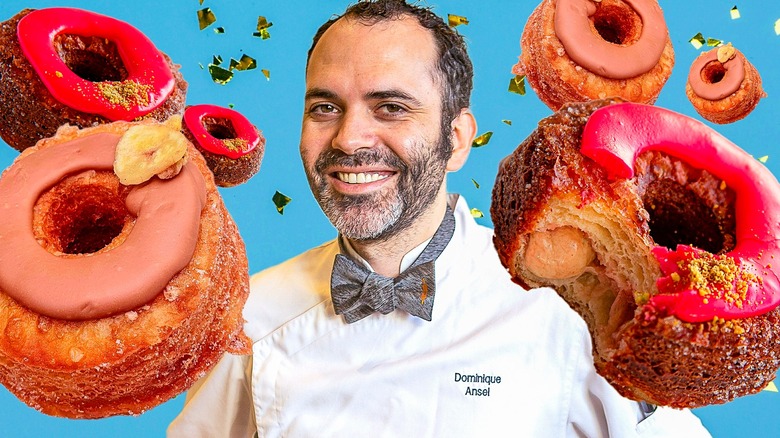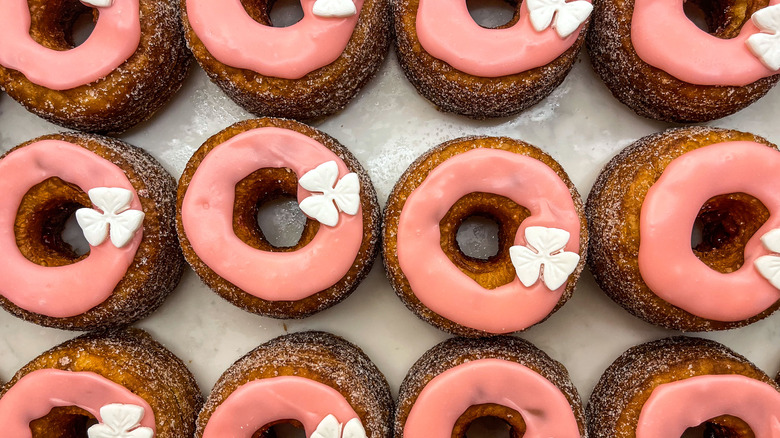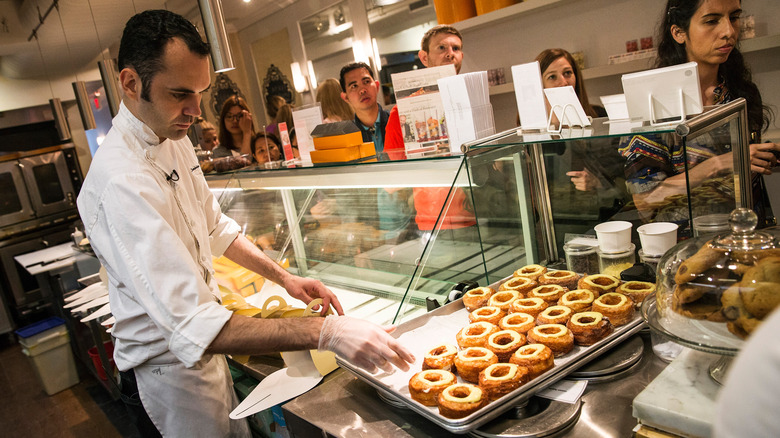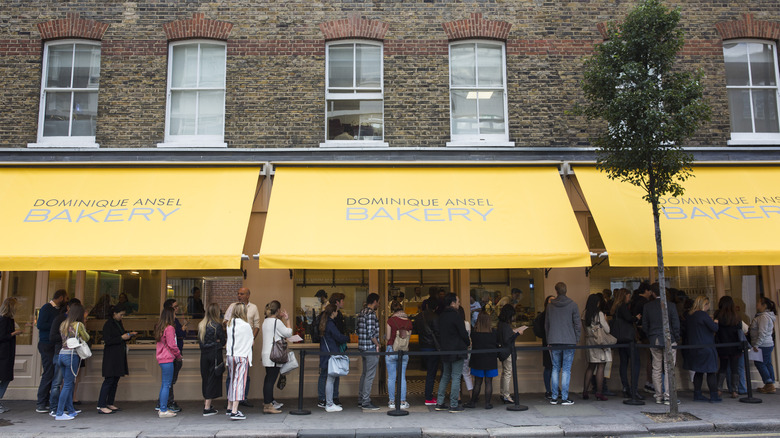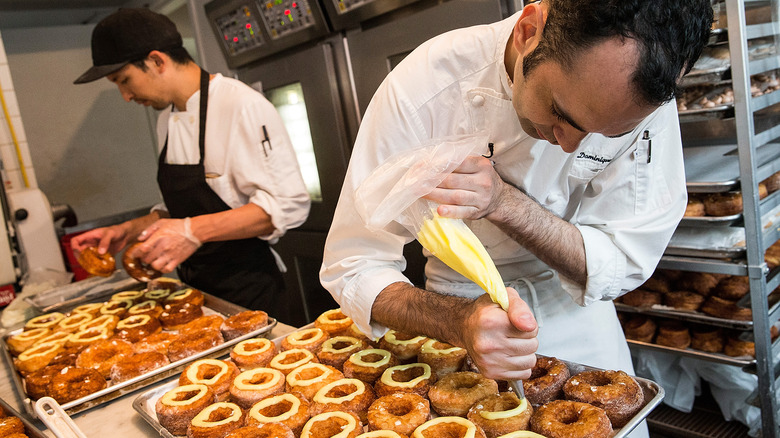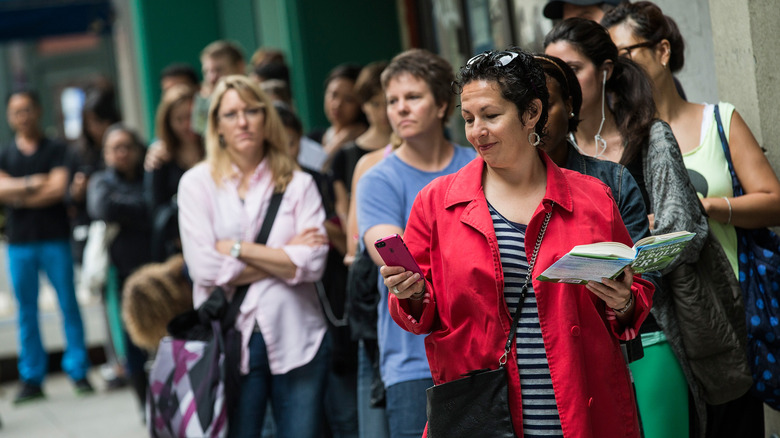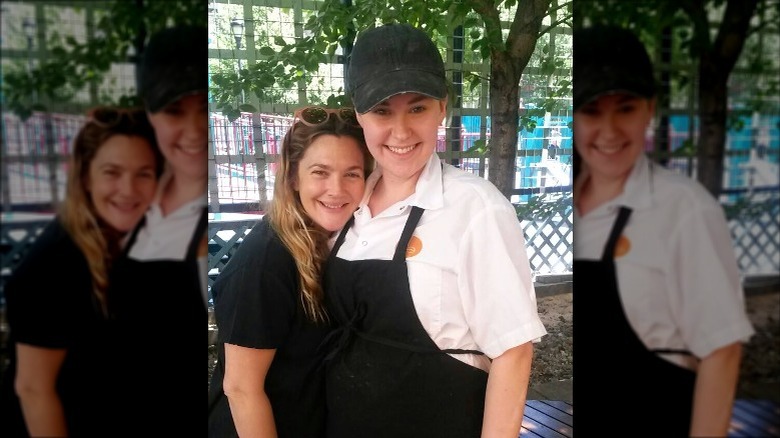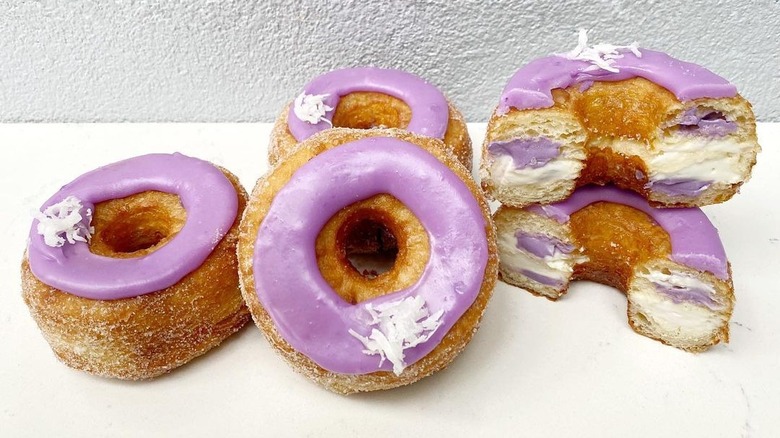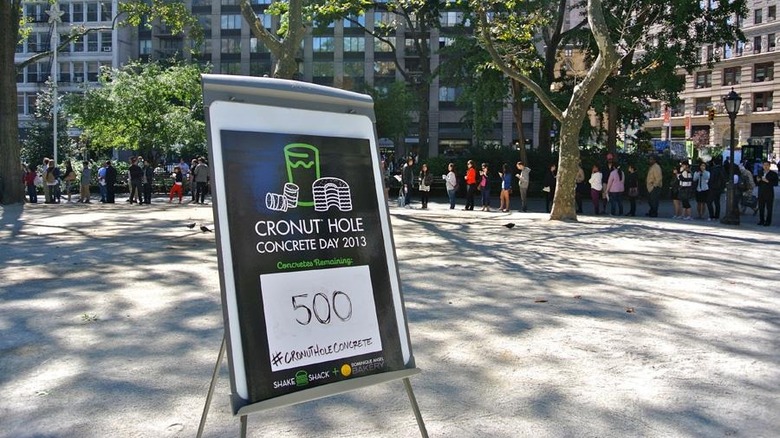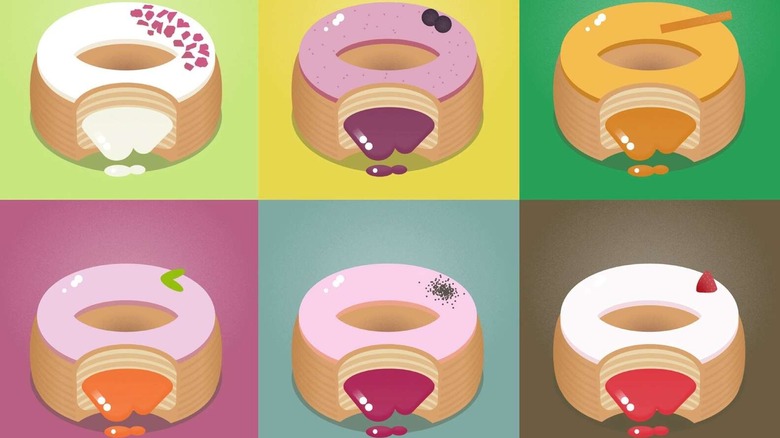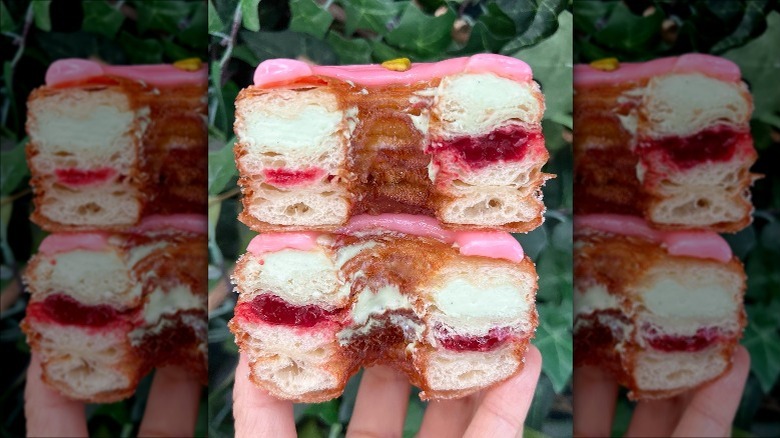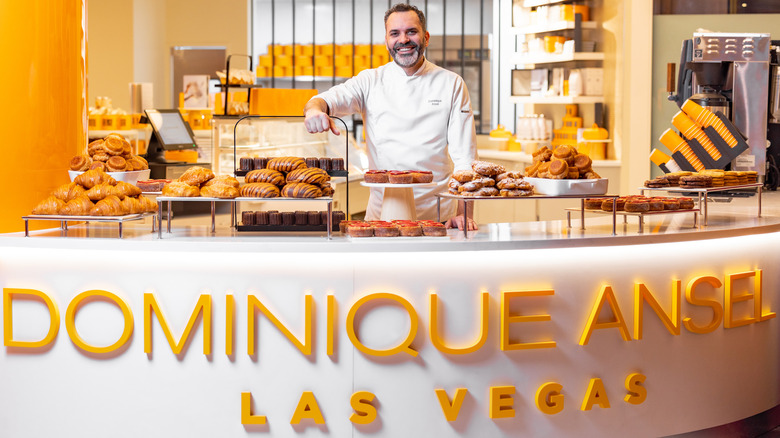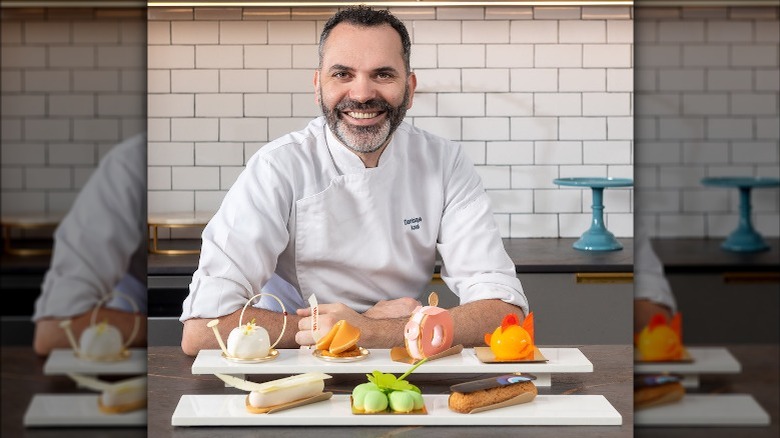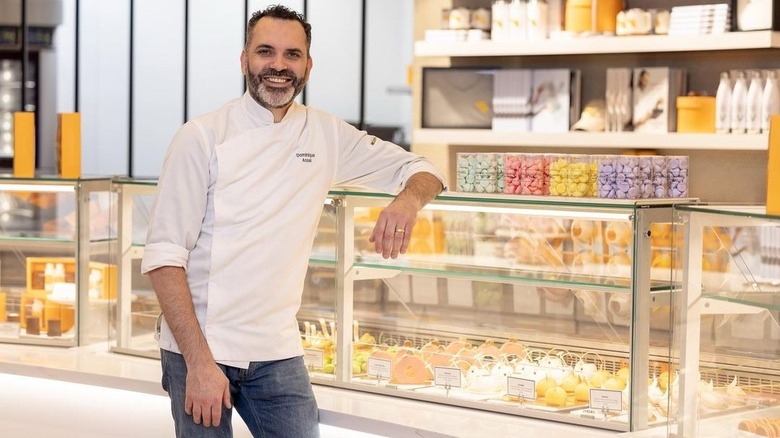The Cronut Turns 10: Dominique Ansel Looks Back On His Iconic Creation - Exclusive
It may have started out as nothing more than a warm, sunny, spring morning in New York City. But Friday, May 10, 2013 was the day that changed the dessert world — not to mention Dominique Ansel's life — forever. Two days ahead of Mother's Day, the pastry chef placed a humble new baked good he simply called the Cronut (it is a cross between a croissant and doughnut, after all) in the display case of his namesake New York bakery with little fanfare. That initial batch sold out in minutes, and as they say, the rest is history.
A decade later, the Cronut is one of the most ubiquitous sweet treats on the planet and Ansel stands atop a sugar-dusted, cream-filled empire. It's hard to overstate the impact of this flaky, fried pastry. It was one of the first viral food sensations, and its rise has been a model for marketing, business, and the power of food to bring people together.
As he prepares to celebrate this major milestone at his now three bakeries — including his newest shop, Dominique Ansel Las Vegas located inside Caesars Palace — Ansel spoke exclusively with Tasting Table to reflect on the last 10 years and how much has changed since that one fateful day in May. The chef opened up about the good, bad, and ugly — from the very first Cronut to the frenzy that threatened to ruin his business, the fight to protect his precious creation, and the far-reaching impact Ansel has made on countless lives and communities, all because of one tiny treat.
Crafting the Cronut took months to perfect
When the idea for the Cronut came about, it was never meant to spark a bakery revolution; it was simply meant to be a fun Mother's Day treat. Ansel says his girlfriend (now wife) was helping him spitball ideas for a holiday treat, and she suggested doughnuts, a perfectly sweet finish to complement Mother's Day brunches all over the city. "I'm French. I don't have a recipe for doughnuts," he recalls telling her. "I grew up eating croissants." At her persistence (and perhaps divine instinct), Ansel started playing around with the idea of combining these two concepts.
Ansel doesn't do anything halfway when it comes to pastry, relying on a detailed, whimsical, almost ethereal approach to confections. This was true even back when he was only preparing a few dozen treats for the New York locals who meandered into Dominique Ansel Bakery, his SoHo flagship.
Ansel says he spent nearly three months working on the recipe for the Cronut, and it took more than 10 different iterations before he nailed it. And it's worth pointing out that the Cronut is much more than a fried croissant. The pastry is made with a unique laminated dough that has to be mixed, rested, formed, and proofed over the course of three days before it is fried at a specific temperature, then rolled in sugar, filled, and topped with glaze and other adornments. "You cannot do it in less than this," Ansel insists. "There's no shortcut."
The Cronut frenzy began as soon as it came out of the oven
The very first Cronut flavor was reminiscent of a spring bouquet perfect for Mother's Day — dusted with rose sugar and rose glaze, filled with Tahitian vanilla ganache, and topped with crystallized petals. The day before its debut, journalist Hugh Merwin offered a preview of the hybrid for Grub Street, New York Magazine's food blog, calling it "a bold step forward for pastry." On May 10, Ansel proudly displayed his newly named creation at 8 a.m. when the bakery opened. Within 35 minutes, all of the cronuts he'd made that day were sold out.
Almost immediately, Ansel's world started to tilt on its axis. "[Merwin] called me telling me he had an increase of traffic of 300% on his website and over 140,000 [clicks] on the article," he says. But Ansel says he didn't grasp what was coming. "I was like, 'I sleep three to four hours a night. I'm very happy for you, but I have to go back to work.'" The journalist cautioned Ansel to be ready for an onslaught, so he planned to prepare a few dozen more pastries in his next batch. That number would fall well short of demand.
Three days in, the bakery had lines around the block
In hindsight, it's easy to laugh at Ansel's humble ignorance of the sensation he had sparked early on. But reality caught up with him quickly. "By day three, we had over 150 people waiting outside before opening the shop," says Ansel. "And this is when the madness started and the stress."
By the second week, both Ansel and his staff of four were stretched to their limit. The pastry chef remembers sending one of his baristas outside to greet the throngs of customers lining up an hour before the bakery opened. By the time he was ready to open the doors at 8 a.m., she still hadn't come back. "I was like, 'oh my God, She walked out on me and she's not coming back,'" says Ansel, who confronted the barista upon her return. "She looks at me, she's like, 'Have you seen the line? It's like four blocks long, and people have hundreds of questions,'" Ansel recalls. "It was I think close to 300-plus people waiting outside. It was just madness."
The Cronut almost ruined Dominique Ansel's business
With a team of five people working in a 100-square foot space, Ansel was in no way prepared to handle the Cronut's viral explosion. "From the outside, it looks beautiful. From the inside we were just crumbling ... I was so overwhelmed every single day," he says. The demand for the Cronut kept growing at a pace that Ansel's bakery simply could not keep up with. "Our kitchen was so tiny," adds Ansel. "We were crushed by requests and people were mad because we couldn't make enough."
While Ansel now fully embraces the Cronut's lasting success, he admitted that those early days were some of the hardest of his career. "I thought it was a curse." He remembered being worried his employees would walk out the door –- and one of them did. "One of our cashier baristas took a look at the line outside and quit on the spot."
Ansel was running on barely a few hours of sleep every night and hardly had the capacity to even make enough Cronuts, let alone figure out how to scale his business before it crushed him. "You feel like everything is collapsing. Everything you build is not working. You will not have enough space. We can't make more. Every day is stress after stress after stress."
In the end, Ansel says it was more than worth it, but of course, hindsight is 20-20. "It was a very simple and humble beginning, and I think it was a painful start to start something beautiful that we've created."
The long Cronut lines bring out the best (and worst) of humanity
Spending hours in a long line with a bunch of strangers who all want the same thing (and have no guarantee it will be available when their turn comes) creates a tense environment, to say the least. And Chef Ansel witnessed firsthand how early demand for the Cronut brought out the worst of people at times.
"People were lining up as early as two o'clock in the morning," Ansel recalls. He quickly recognized that a whole bunch of tired customers in dire need of a sugar high is no doubt a recipe for disaster. "Your guests are upset ... they start screaming at you. They start insulting your stuff." The crowds got so out of control at times that Ansel hired private security to protect the employees on top of managing the mayhem outside. "People were cutting the line. They were screaming at each other. The neighbors were calling the police," he says, noting that tensions would occasionally lead to violence. Adding to the chaos were various solicitors who were taking advantage of the opportunity to sell anything and everything to grumpy and hungry customers.
But for all the chaos, Ansel says there have been more beautiful moments than bad ones. He fondly remembers the many first dates and wedding proposals (several dozen that he can count) that have happened in line. He's heard stories of families reconnecting, friendships made, and even couples who met each other in line who now come back with their children.
Even your favorite celebrities have waited in line for Cronuts
Every Cronut fan knows that when the day's supply is sold out, that's it. And that fateful moment usually comes a few hours after opening, which is why people come early, prepared to wait for a chance at scoring that coveted ring of fluffy, fried goodness. For better or for worse, the Cronut lines are here to stay, and no one is exempt.
The Cronut has countless celebrity fans from Heidi Klum to Drew Barrymore, Joel McHale, Martha Stewart, and more — and Ansel admits he's had to tell some of them to get in line, noting, "I want to be fair with everyone." Ansel remembers an instance when he was approached by a famous Hollywood director. "This guy was like, 'I'm the executive director of this movie.' I was like, 'Congratulations. Good job. The line is right here.'" It's also been reported that Emma Watson once tried to cut the line and was turned away. While that couldn't be confirmed be Ansel, he did recall a run-in with an A-lister who didn't try to flex his star power. "I saw Leonard DiCaprio waiting in line," he says. "I think that day he got the last one. He got lucky."
And there's no friends and family perk, either. According to Ansel, "Even some of my family who were in New York, I told them to go wait in line, and they didn't want to and they didn't try the Cronut."
Dominique Ansel almost lost the rights to the Cronut
Like most viral sensations, Cronut imitators were quick to spring up en masse, keen to jump on the bandwagon and reap the rewards. Just three months after the pastry debuted, there were dozens of copycats being sold all over the globe — even prompting a World Cronut Map. This form of flattery was understandably bittersweet for Ansel at first. "I think it's nice that people enjoy it. It's nice that people wanted to try it, but at some time when they rip you off to try to make a business out of it is a different feeling," he says. And on top of that, he insists the imitators don't even get it right. "I've tried a few, but it's always really bad," reveals Ansel.
Nowadays, you won't find many people pretending to peddle a legitimate Cronut, because Ansel's creation is trademarked. But he almost lost the rights to the name in the process. At first, Ansel didn't even think he needed to get legal protection. But a lawyer friend insisted on it and offered to take care of it for free. And thank goodness for that. Ansel filed a trademark application 10 days after he sold his first Cronut. "Five days later, there were like 27 applications for the same name brand," he notes.
One of Shake Shack's longest lines ever was thanks to the Cronut
The Cronut's sustained popularity over the last decade has ushered in countless opportunities from brands who want to partner with Dominique Ansel and enjoy a brief moment of basking in the Cronut's spotlight. One of those brands was Shake Shack, which has never needed anybody's help racking up a long line (if you've been to Madison Square Park during lunchtime on a sunny day, you know).
Ansel said it was an "epic" experience for him when they first collaborated in 2013 for Cronut Hole Concrete Day, the first time the burger chain had ever teamed up with another chef. (According to Ansel, the connection was a result of his friendship with Shake Shack founder Danny Meyer.) The two budding New York food icons teamed up to create a Cronut hole concrete, one of Shake Shack's signature desserts. And in Ansel's words, it was "massive." The line wrapped all the way through and around the park. Even despite the Cronut fervor, Ansel couldn't believe the size of the crowd, particularly since sales started at eight in the morning — not exactly a popular time to consume ice cream. Ansel says he remembers Meyer himself telling him, "This is one of the longest lines I've ever seen at Shake Shack."
Cronuts aren't just for eating
Over the years, the Cronut has helped create a platform for Ansel to give back to the community, something he's been passionate about since day one. "Someone reached out through Twitter comparing the Cronut line to the people that were waiting for food stamps, and I realized that we should do something," Ansel recalls, adding "I suffered from not always having food on the table when I was a kid, so fighting against hunger in New York City is something that's very dear to me." In the first year of the Cronut, Ansel said the bakery "raised over $100,000 to fight against hunger in New York City, auctioning off 12 Cronuts."
Beyond giving back to the community, Ansel is passionate about fostering his own community of Cronut fans as well. "There's hundreds of stories I could tell you about what it means for people to come to the bakery." This led him to create a whole new kind of Cronut you can't eat. In 2022, Ansel released a 60-piece collection of NFTs so people could own their own piece of the Cronut legacy forever — and get access to special bakery perks. "The NFT for me was a new form of art," he explains. "It was also a way to reach out to people ... to give them a little piece of what we do."
The Cronut turned Dominique Ansel into an accidental marketing genius
There are two things that will forever be true about the Cronut: Every month brings a new flavor, never to be repeated and production will be limited. This policy initially emerged as a way for Ansel and his overwhelmed bakery to keep their head above water, but over the last decade, it has proved to be an incredibly efficient marketing strategy.
All Cronuts are made on-site at Ansel's bakeries. While people have pushed him to expand, he has remained true to his own vision of a small footprint focused on quality and creativity. To date, nearly 120 flavors have been created at Ansel's NYC bakery (and more than 250 when you count his London and Las Vegas locations). Ansel notes that "every time there's a new flavor, we have an influx of sales." People go crazy all over again, "and they're very expressive through social media." (As for the most divisive Cronut flavor, Ansel points to a holiday peppermint and chocolate combo served a few years back that yielded a love/hate response.)
All of these factors — production limits, rotating flavors, and online engagement — have created a built-in marketing machine. Meanwhile, bakeries everywhere have looked to create their own viral breakout, but it is a "dangerous game" according to Ansel. "You don't focus anymore on your guests ... You focus on yourself and the way you look." As for Ansel, his focus is to "give the best product, the best quality, the best creativity, and I will have people come back for it because it's good."
The Cronut's biggest legacy goes way beyond its craveability
Like every food business, the COVID-19 pandemic had an impact on Dominique Ansel's bakeries. It will forever be an important piece of the Cronut's history in more ways than one. Yes, sales took a hit for a time during the height of the pandemic (despite the fact that they still remained open every day) and Ansel's London and Los Angeles bakeries turned the lights off in the summer of 2020. (His Hong Kong bakery, Dang Wei Li by Dominique Ansel, which debuted in early 2020, remains open along with a sister location at H Queens.)
But the larger impact was positive overall. Ansel says COVID showed just how much the Cronut experience is all about community. According to Ansel, as the world shut down in 2020, the bakery was a refuge for so many. "People were walking from the Upper East Side to the bakery, people were coming from New Jersey just to come to the bakery," he says. "it was a place where people were coming to socialize, where people were coming to connect. A lot of dogs, a lot of families, a lot of people meeting at the bakery to grab a coffee, just to chat."
Ansel also recalls a particular customer with a pregnant wife who got himself through the pandemic on Cronuts. "During the height of the pandemic when hospitals didn't allow guests, he couldn't accompany his wife to appointments," says Ansel. "He waited in the Cronut line each month instead, so they could share pastries together."
The one thing that changed Ansel's life more than the Cronut
While the success of the Cronut altered the course of Ansel's trajectory, another life-changing moment had a far greater impact. "I had a boy three years ago, right in the middle of the pandemic," he says. And in a true twist of fate, his first child was born on the anniversary of the Cronut. "It's a sign from the sky," as Ansel put it. But it wasn't without challenges. Ansel's son was born two months early and had to spend 40 days in the NICU. All the while the world was shutting down from a pandemic, Ansel was trying to keep his business afloat and had to navigate laying off staff members. "It was tough," he says.
Now, Ansel's biggest challenge isn't keeping up with the Cronut's massive demand, but rather "learning how to be a good parent," and juggling his business and family life. "It's not easy, and it's very humbling," he admits. Adding to the mix, Ansel and his wife welcomed their second child, a daughter, early in 2023, making this a year with a lot to celebrate.
The Cronut has taken Las Vegas by storm
Setting up shop at Caesars Palace on the Vegas Strip was a natural continuation of the Cronut's ascent into the annals of culinary history. Since October 2022, Dominique Ansel Las Vegas has been serving up gorgeous and delicious pastries and confections, crafted at such a high level that it almost feels sinful to eat them –- but that's not stopping anyone in Sin City.
Stylish visitors preparing for a day of big spending or capping off an elegant dinner flock to the bakery every day for Ansel's signature treats, including his Frozen S'mores, Cookie Shots, and Dominique's Kouign Amann (his best-selling caramelized croissant) — and, of course, Cronuts. Fanfare is built into Ansel's baking DNA, so upon coming to Vegas, he kept his focus on "being approachable, touching people emotionally, connecting with people." Not only does he continue to wow the tourists who want to see edible works of art, but also the regulars, and even the other foodies in the business who simply want, as he puts it, "to have a good croissant, good coffee in the morning."
Countless Cronuts later, Ansel is right where he wants to be
Ansel has made it clear that he has no desire to scale his bakery operations to the level that would be required to fully fulfill demand for the Cronut. "Of course you can take the money, take the big checks," he acknowledged. And with his success, he knows he could probably even walk away and retire.
But 10 years and well over a million Cronuts later, Ansel has hit his sweet spot, so to speak, and he's embracing the crowds, which have barely let up, especially on the weekends. "The Cronut is very much still alive ... We still sell out every single day. We still change the flavors ... We still celebrate." This difference is that now, Ansel says his team has "systems in place, we have good operations, we have control over the crowd, the staff, over everything."
Ansel attributes that to two things. For one "we've learned the hard way, because when we first started we were not prepared for this." And secondly, he remains committed to living in the present. "The most important thing is to focus on what we have right now." And what he has right now is global recognition for one of the most popular pastries on the planet — and he's good with that. "There's always people reaching out and wanting us to do things ... but it has to be mindful and it has to be the right time and the right place."
How Ansel really feels about his Cronut legacy
For another chef, the massive success of the Cronut might spark the determination to create something even bigger and bolder. But Ansel is content if this is the peak of his celebrity career. "I'm very humbled to have a legacy," he said. "Not everyone has something that people can remember." And according to Ansel, that legacy is bigger than the Cronut, anyways — it's about the unique experiences people have at the bakery, "the emotions and the memories you leave with people," whether that was a proposal, a new friendship, or a chance to feel connected to a community.
The chef says he will always keep creating, but he's not worried about outdoing that legacy. "I never intended to, and I don't think I should," he said. Of course, he's created plenty of jaw-dropping treats since then. "I created the Frozen S'mores just a few months after creating the Cronut ... It went viral. I created the cookie shot after the Frozen S'more. It went viral ... Those are fun, good, and meaningful creations. They were never intended to top the Cronut. They were always intended to keep the creativity going."
For Ansel, the Cronut and everything since has been a once-in-a-lifetime dream. "Even if you give me all the money of the world, I don't think I can specifically target and recreate the same experience. I think it was genuine, it was natural, and it came out of love and care for pastry."
